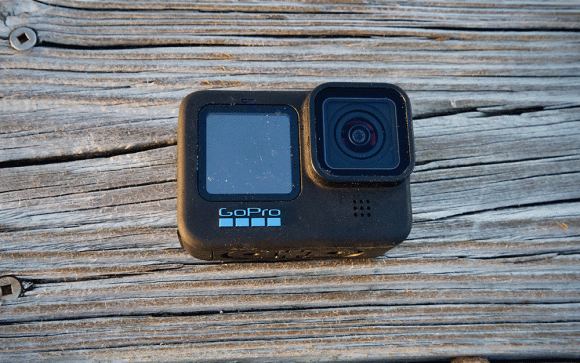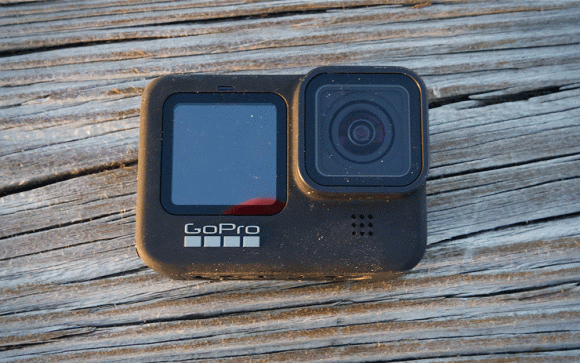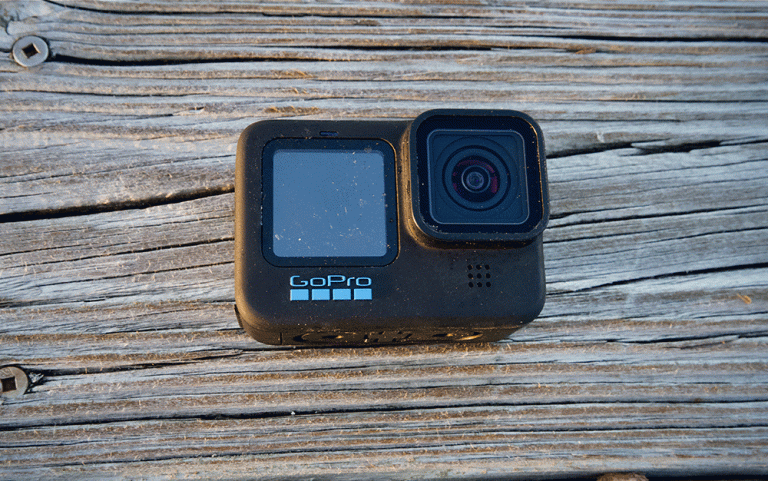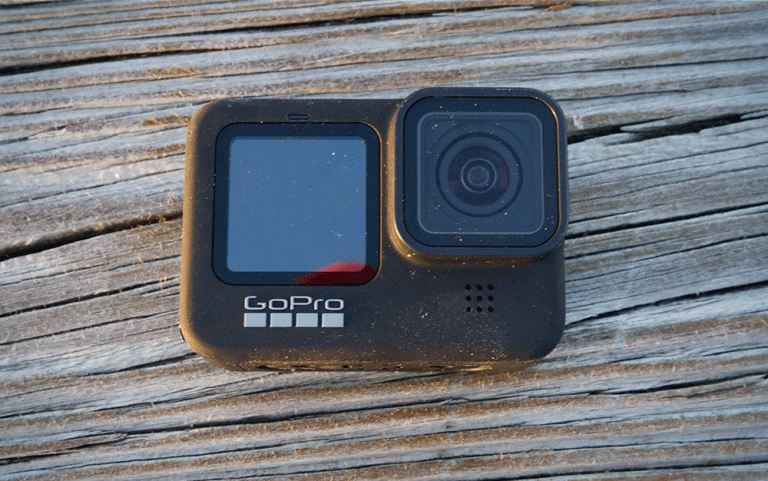We may earn revenue from the products available on this page and participate in affiliate programs. Learn More ›
I’ve shot commercials, real estate videos, and YouTube videos with expensive camera setups. But, I’ve always had a place in my camera bag for a GoPro. That’s because they can do things that even six-figure cinema cameras can’t do. For example, you can attach them to things, squeeze them into tight places, and they’re waterproof. The compromise was that the small cameras lacked video quality until recently. The GoPros now shoot above 1080p (full HD) at impressive frame rates. The question isn’t, should you own a GoPro? It’s: what’s the best GoPro for me?
- Best Overall: GoPro Hero 10
- Best Budget: GoPro Hero 9
- Best for 360 Footage: GoPro MAX
I’ve been shooting with the GoPro Hero10, Hero 9, and MAX for two months to help you answer that question. Whether you already have a Hero 8 or 7 and are trying to decide if you should upgrade or are looking to get your first GoPro, I’ll help you decide which is the best GoPro for you.
Best GoPro Overall: GoPro Hero 10
Pros
- In-camera video stabilization
- Incredible photo and video quality in a small package
- Amazing slow-motion video
- Can be used to shoot everything from cinematic footage to a vlog
Cons
- Low battery life
- Need to buy extra accessories to use an external mic
Key Features
- 5.3K 60 fps
- 4K 120 fps
- 2.7K 240 fps
- Waterproof to 33 feet
- 1080p streaming
- 23.6 MP sensor
- Front-facing LCD screen
- 3.5mm Audio Mic Input with Media Mod for HERO10 Black
- Wi-Fi, Bluetooth, and GPS enabled
- Rechargeable battery

Product Overview
GoPros were always used as crash cams and for a second point of view in tight places, but holy crap, they’ve come a long way. The GoPro Hero 10 can shoot pro-level footage at 5.7K and incredible slow motion at 4K 120 fps. It also shoots really nice photos for a video camera.
If you have an older GoPro, one thing you’ll appreciate in the new cameras is you no longer need to use a cage to mount your camera to GoPro accessories. The mont is built-in and flips out from the bottom of the camera. It’s a smart design and a significant improvement because you don’t need to take off a cage to swap batteries.
For the longest time, the downfall of GoPros was their wide field of view made it difficult to film things more than a few yards away. The Hero 10 and 9 both can select between linear, narrow, and wide fields of view. I most often choose linear, but if you want to make a four-pound bass look like a six-pounder, the wide FOV will do the trick.
The Hero 10 has a slightly bigger sensor than the Hero 9, 23.6 vs. 20 MP, which means it can gather a little more light and offers a better picture in low light situations. For perspective, an iPhone 13 has a 12 MP sensor.
Another notable feature is Scheduled Capture, which lets you set the time you want the GoPro to start recording so you’ll never miss another sunrise video when you want to hit the snooze button.
Footage Review

The footage on the GoPro Hero 10 Black is amazing. The above sample footage is straight out of the camera with no color grading or adjustments. It’s a 4K project, and some footage was shot in 5K. I edited the footage using the free GoPro Quick app on my phone. I’ll let the footage speak for itself, but you’ll see how the camera performed in low light, bright sun, and filming directly at the sun. It’s also worth noting that the video was filmed on a moving boat in rough conditions. All the footage was shot without a gimbal, and it’s a testament to the Hero 10’s advanced in-camera stabilization.
Cons
The two cons of the Hero 10 are not unique to this model. All the GoPros tested struggled with battery life and touch screen response.
I had issues with the GoPro touch screen in cold weather. The screen didn’t respond and I had to warm up my hands to get the screen to work. That can be frustrating when you’re toggling between settings on a cold day.
The biggest con of all GoPros is battery life. I highly recommend buying at least one extra battery for any GoPro you buy. You’ll get about an hour or two on one battery if you’re shooting continuously. But, I recommend using QuickCapture mode, which turns the camera on and starts recording when you press the record button. This allows you to save battery and not miss a moment.
Who Should Buy It
If you want the best GoPro available and want a pocket-sized cinema camera, then this is the GoPro for you. Though, if you have a Hero 8 or earlier, I’d say bypass the 9 and upgrade to the 10. If you are looking for your first action cam, your budget will be the deciding factor between the two. There have been some really good sales on GoPros lately that narrowed the price gap to make the decision a no-brainer.
Best Budget: Go Pro Hero 9
Pros
- High-quality video
- Excellent in-camera stabilization
- Easy to use
Cons
- Battery life
Key Features
- 20 MP sensor
- 5K 30 FPS
- 4K 60 FPS
- 1080p 240 fps
- 3.5mm Audio Mic Input with Media Mod
- Live streaming in 1080p
- Waterproof to 33 feet
- Wi-Fi, Bluetooth, and GPS enabled
- Rechargeable battery

Overview
The GoPro Hero 9 is a few years old now, but it still competes with the best. You’re getting a camera that shoots 5K video at 30 frames per second, which gives footage a cinematic look. You can also shoot high-definition super slow motion at 240 frames per second. It wasn’t long ago that you had to buy a very expensive camera to shoot slow motion at that frame rate and image quality. It, of course, does everything that GoPros are known for, like great stabilization, and it’s waterproof to 33 feet.
The Hero 9 and 10 have a cool stabilization feature called horizon leveling, which automatically keeps the horizon level in the frame. If you’re running or on a boat or kayak, this is a nice feature to keep your footage smooth. The stabilization is so good on GoPros that you don’t need a gimbal to shoot shake-free cinematic footage. To me, it’s what separates GoPro from other action cams.
Footage Review

You’ll see Hero 9 sample footage shot in various lighting conditions and on a moving boat in the above video. In my opinion, the quality is good, but the Hero 10 footage recorded on the same day is noticeably better. The most significant differences I noticed are in bright sun, the Hero 9 video was flatter, and the Hero 10 had better stabilization. In ideal lighting and around golden hour, the two cameras were very close in performance.
Cons
GoPro has always made using external mics difficult by forcing users to buy expensive adapters. If you want crisp audio from an external shotgun mic like the Rode Video Micro or the GoPro directional mic, you’ll have to pony up $80 to get the Media Mod.
Also, like the Hero 10, the Hero 9 has poor battery life, and the touch screen wasn’t responsive in cold weather.
Who Should Buy It
The Hero 9 is $100 less than the Hero 10, and we’re splitting hairs when it comes to the practical difference between the two cameras. The 10 shoots better video and photo, but the 9 will serve most people well. I’d recommend the Hero 9 Black for people upgrading from an older GoPro or the casual user who doesn’t need the Hero 10’s advanced features.
Best for 360 Footage: GoPro MAX
Pros
- Does things other GoPros cannot
- Good for vlogging
- Versatile camera for photos and video
- Excellent stabilization, better than the other GoPros
Cons
- Not the best choice for underwater video
- No slow motion
- Wide lens distorts close subjects
Key Features
- 360 video in 5.6K 30 and 24 FPS
- 360 audio
- Regular video in 1440p and 1080p
- Spherical photos, PowerPano, and regular photo
- 360 Timewarp and time-lapse video
- LCD touch screen
- Waterproof to 16 feet
- Wi-Fi, Bluetooth, and GPS enabled
Overview
This camera is in its own category of action cams and can’t be directly compared to the Hero 10 or 9 because it fills an entirely different use case than your typical camera. The Hero MAX shoots 360-degree footage, so you’ll capture everything that happens. You can get some very cool perspectives with a 360 cam, and one of the best uses is as a second point-of-view camera for filming hunts.
It shoots 360 degrees in 5.6K at 30 and 24 frames per second. You can also shoot 3K at 60 frames per second, which is a high enough frame rate to slow down footage a little without it getting glitchy. The interesting thing is that you can’t shoot at a lower resolution than 3K, leading to some whopper-sized files in post.
Editing Workflow
People have been slow to adopt 360 cameras because the workflow is more complex than standard video. Editing footage from the Hero MAX is an excellent example of the added complexity you get with 360 video. This isn’t a camera for beginner editors, and you’ll want to watch a few editing tutorials before jumping into your project.

Cons
The MAX is waterproof, but you can’t film with it underwater, and you’ll get nothing but blurry video and disappointment if you try. However, the waterproofness is nice for rain and snow or protection against Murphy’s Law.
I wish you could film slow motion with the 360 camera. Slow-motion should be standard on action cams because it’s nice to slow things down at key moments when filming action.
It’s fantastic that you can shoot regular video with the MAX, but it’s easy to have the camera in regular video mode when you want to be shooting in 360. That’s because the camera defaults to normal video when you turn it on, even if you were shooting in 360. There’s also just one mode for video, and then you must select 360 on the touch screen rather than the mode button.
Who Should Buy It
There’s some stiff competition in 360 video cameras like the Insta 360 One X2. Especially now that the newest Insta 360 camera is waterproof. If you’re in the market for a 360 action camera, I would recommend comparing the MAX vs. the One X2 to see which best suits your needs.
Best GoPro Accessories
Best SD Card for GoPros
SanDisk Extreme 128 GB micro SD card will give you more than four hours of 4K recording. Trust me, you don’t want to fill up that SD card and have to edit the footage down to a two-minute video.
GoPro External Mic Adapter
If you want to use an external mic, you’ll have to buy a GoPro Media Mod. It’s an $80 accessory, which stings, but I think it’s worth it if you need to capture audio with your GoPro.
Batteries
Extra batteries are a must for GoPro users. If you have one extra you can charge your dead one with a power bank, while you continue filming.
Tripod and Monopod

The 3 Way 2.0 combines a tripod and monopod into one handy accessory. It folds up into a small package and fits easily into a backpack’s water bottle pocket or even a cargo pocket. Whether you need to do a stationary shot with the tripod or a walking monologue with the monopod, the 3 Way 2.0 can do it all.
GoPro Quik App
I don’t usually use the GoPro editing app, but I used it throughout the review process. It’s very easy to transfer files from your camera to the app. For simple videos, the GoPro app is excellent. In a few minutes you can splice a few clips together, add music, and export it to your camera roll.
Filters
If you’re shooting in bright sun or around water, a UV or polarizer filter is a great investment into getting better video from your camera. PolarPro makes great GoPro filters and even ones designed for underwater use.
Accessories for Filming Hunting and Fishing
The easiest way to self film a hunt or fishing trip is with the HeadStrap or QuickClip. With those accessories, your GoPro will mount to your hat or strap onto your head. Then where you look, the camera will record. The downside is that wearing a camera on your head isn’t comfortable over extended periods. The next best thing for fishing is the Chest Rig, which mounts the GoPro on your chest to give the viewer a similar point of view to what you’re seeing.
You can get a lightweight camera arm for hunting, like the Fourth Arrow Outreach, or a tripod for filming with a GoPro. They’ll stabilize the camera and still keep your hands free for making a shot. But, you’ll have to be more active in filming by making sure what you’re trying to film is in frame.
For fishing, the El Grande monopod in a rod holder is a good option in a kayak or boat. A Goose Neck attached to the Jaws clip will attach to a centercole’s T-top, or a poling platform.
Which GoPro Should You Buy?
As I said earlier, for outdoor filmmakers, it’s not a question of if you should buy a GoPro. It’s: which GoPro should you buy? The answer will depend on what you need from your action cam. If you want to give viewers a unique perspective, the MAX with its 360 video recording is the ticket. However, it’s good sense to research competitive 360 camera offerings.
The more complicated decision is the GoPro Hero 9 Black vs. Hero 10 Black. In late 2021, my general recommendation is the Hero 10 because I think the price difference is worth it for the better quality video and slow-motion options. But, not everyone needs the Hero 10’s 2.7K 240 FPS slow-motion.
If you’re upgrading your Hero 8 or older GoPro, you’ll be happy with either the Hero 10 or 9. Comparing my Hero 7 to the 10 and 9 is like comparing a house cat to a catamount. They’re different animals, and anyone coming from an older GoPro will notice a huge jump in performance with either model.
FAQs
GoPros take great pictures. The Hero 9 is 20 megapixels, and the Hero 10 is 23 megapixels. Both are more than double the megapixels of an iPhone.
How long a GoPro records depends on environmental conditions and settings. But, you can expect one to two hours per battery.
The best GoPro for the money is surprisingly the most expensive, Hero 10 Black, because it offers exceptional features for the price.
Final Thoughts on the Best GoPros
A videographer’s filming and editing skill will outweigh the quality of the camera. The amazing videos people produce with cell phones is a great example of what you can do with creativity and less-than-ideal tools. So if you want to shoot better video, buy the best GoPro you can afford, practice with it, and learn all you can about editing and shooting video.
- Best Overall: GoPro Hero 10
- Best Budget: GoPro Hero 9
- Best for 360 Footage: GoPro MAX






